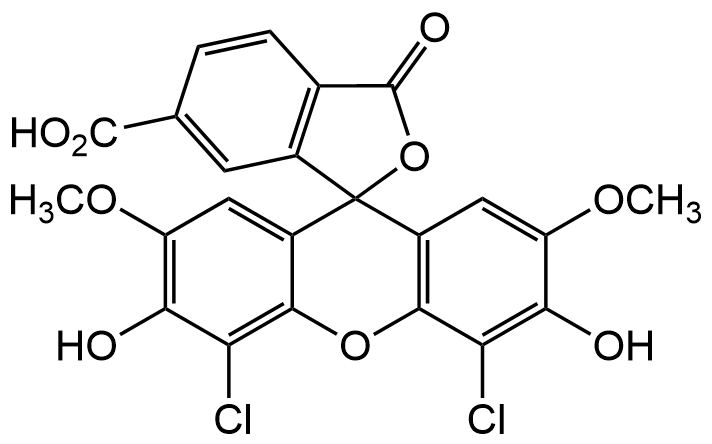6-Carboxy-4',5'-dichloro-2',7'-dimethoxy fluorescein
| Code | Size | Price |
|---|
| CDX-C0687-M005 | 5 mg | £80.00 |
Quantity:
Prices exclude any Taxes / VAT
Overview
Regulatory Status: RUO
Shipping:
Ambient
Storage:
Short term: +20°C, Long term: +4°C
Images
Documents
Further Information
Alternate Names/Synonyms:
6-JOE
Appearance:
Solid.
CAS:
82855-40-1
EClass:
32160000
Form (Short):
solid
GHS Symbol:
GHS07
Handling Advice:
Protect from light and moisture.
Hazards:
H302-H315-H319-H335
InChi:
InChi=1S/C23H14Cl2O9/c1-31-13-6-11-19(15(24)17(13)26)33-20-12(7-14(32-2)18(27)16(20)25)23(11)10-5-8(21(28)29)3-4-9(10)22(30)34-23/h3-7,26-27H,1-2H3,(H,28,29)
InChiKey:
IDLISIVVYLGCKO-UHFFFAOYSA-N
Long Description:
Chemical. CAS: 82855-40-1. Formula: C23H14Cl2O9. MW: 505.26. JOE is a conventional fluorophore predominantly used in automated DNA sequencing. Characterized by an intermediate-wavelength spectra, high quantum yield, and low pH sensitivity in the physiological range. Has a similar absorption and emission spectra to those of rhodamine 6G. Spectral Data: lambdaex 520nm, lambdaem550 nm in Buffer pH 12; lambdaex 520nm, lambdaem 548nm in DMSO. JOE possesses an absorbance (?520 nm) and emission (?550 nm) red-shifted compared to those of carboxyfluorescein (FAM). The substantial difference in emission wavelengths of FAM and JOE makes them spectrally resolvable and allows simultaneous use of both dyes in multiplex assays. JOE had been applied as a fluorescent label in DNA sequencing, PCR, and LCR amplifications. It is a common fluorophore used in various formats of DNA sequencing based on the laser excitation of electrophoretically separated labeled DNA fragments, e.g. two dyes (FAM and JOE) labeled primers, four dyes (FAM, JOE, TAMRA, ROX) labeled primers, energy transfer primers, and dye-labeled terminator techniques. Oligonucleotides labeled with JOE found applications in an assay functionally equivalent to Southern blotting, short tandem repeat (STR), and single strand conformational polymorphism (SSCP) techniques. Many real-time PCR platforms have spectral channels suitable for JOE, and it is a common reporter dye in TaqMan probes, PNA molecular beacons, self-quenched probes LUX, and HyBeacons. Other applications of JOE in nucleic acid technology are fluorescent detection of mRNA, DNA arrays and solid phase minisequencing, multiple SNP genotyping, methylation assay, detection of DNA-binding proteins and ribosome-mRNA complexes, and attaching of JOE-modified oligonucleotides to gold nanoparticles.
MDL:
MFCD01311844
Molecular Formula:
C23H14Cl2O9
Molecular Weight:
505.26
Package Type:
Vial
Precautions:
P261-P305+P351+P338
Product Description:
JOE is a conventional fluorophore predominantly used in automated DNA sequencing. Characterized by an intermediate-wavelength spectra, high quantum yield, and low pH sensitivity in the physiological range. Has a similar absorption and emission spectra to those of rhodamine 6G. Spectral Data: lambdaex 520nm, lambdaem550 nm in Buffer pH 12; lambdaex 520nm, lambdaem 548nm in DMSO. JOE possesses an absorbance (?520 nm) and emission (?550 nm) red-shifted compared to those of carboxyfluorescein (FAM). The substantial difference in emission wavelengths of FAM and JOE makes them spectrally resolvable and allows simultaneous use of both dyes in multiplex assays. JOE had been applied as a fluorescent label in DNA sequencing, PCR, and LCR amplifications. It is a common fluorophore used in various formats of DNA sequencing based on the laser excitation of electrophoretically separated labeled DNA fragments, e.g. two dyes (FAM and JOE) labeled primers, four dyes (FAM, JOE, TAMRA, ROX) labeled primers, energy transfer primers, and dye-labeled terminator techniques. Oligonucleotides labeled with JOE found applications in an assay functionally equivalent to Southern blotting, short tandem repeat (STR), and single strand conformational polymorphism (SSCP) techniques. Many real-time PCR platforms have spectral channels suitable for JOE, and it is a common reporter dye in TaqMan probes, PNA molecular beacons, self-quenched probes LUX, and HyBeacons. Other applications of JOE in nucleic acid technology are fluorescent detection of mRNA, DNA arrays and solid phase minisequencing, multiple SNP genotyping, methylation assay, detection of DNA-binding proteins and ribosome-mRNA complexes, and attaching of JOE-modified oligonucleotides to gold nanoparticles.
Purity:
>97%
Signal Word:
Warning
SMILES:
O=C(C1=CC(C2(C3=C(OC4=C2C=C(OC)C(O)=C4Cl)C(Cl)=C(O)C(OC)=C3)O5)=C(C=C1)C5=O)O
Solubility Chemicals:
Soluble in DMSO (5mg/ml).
Source / Host:
Synthetic
Transportation:
Non-hazardous
UNSPSC Number:
41105331
Use & Stability:
Stable for at least 2 years after receipt when stored at +4°C.
References
(1) F.F. Chehab & Y.W. Kann; PNAS 86, 9178 (1989) | (2) S. Carson, et al.; Anal. Chem. 65, 3219 (1993) | (3) S.C. Hung, et al.; Anal. Biochem. 238, 165 (1996) | (4) A.N. Glazer & R.A. Mathies; Curr. Opin. Biotechnol. 8, 94 (1997) | (5) M. Hahn, et al.; Electrophoresis 22, 2691 (2001) | (6) L.J. Kricka; Ann. Clin. Biochem. 39, 114 (2002) | (7) K. Petersen, et al.; Mol. Cell Probes 18, 117 (2004) | (8)I.M. Mackay; Clin. Microbiol. Infect. 3, 190 (2004) | (9) D.A. Trybulsky, et al.; J. Org. Chem. 77, 977 (2012)



